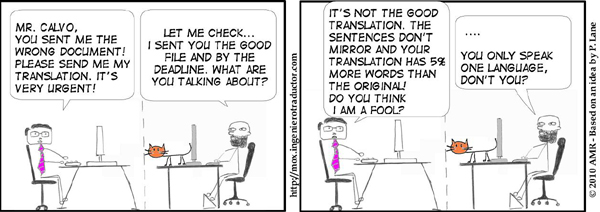Client bloopers: Translator, you sent me the wrong file!
Many of you know Mox’s Blog and his acerbic take on the translation profession (if you don’t, stop whatever you are doing and head on over there). Mox is always looking for subject matter on which to base his hilarious cartoons. This is my contribution to the sometimes-absurd exchanges professional translators have with (monolingual) clients.
Some time last year, a client – we’ll name him Monsieur M. to protect his good name – asked me to translate a press release from French into US English. This communiqué announced a major event for his young company and was written in a very ‘markety’, trendy and catchy style.
As is often the case, a close-to-the-source-text translation would fall flat. Also, and readers, you know this: a press release for the US market is structured quite differently from a French communiqué.
So I revamped the document to make it fit-for-purpose. Adapted the style and mode of communication (French is a high context language and culture, American a low context one). Rreplaced French popular culture references with American ones. Polished up the text and sent it off to Monsieur M.
An hour later, the phone rings.
Monsieur M.: Patricia, you’ve sent me the wrong file. This is not the translation I asked for.
Me: Pardon? [panic attack sets in] Hang on; let me look into this …. [Double-check sent email and attached file]. Si, si! It’s the right file [provide file name], are you sure you opened the right document?
Monsieur M.: I am sure you sent me the wrong file. My communiqué had 4 paragraphs and 24 lines. This file has 5 paragraphs, but only 17 lines. And everyone knows a good translation respects the source file’s layout and appearance. This thing does not look anything like my communiqué.
Tags: client bloopers, client education, client relations, linkedin, Mox's blog, Translation






Hi Patricia,
how was the misunderstanding solved in the end? Just curious…
Quite simply by my taking the time to educate my client on what a fit-for-purpose translation is and what that kind of adaptation requires.
We went through both documents point by point. No one had ever bothered to explain such things to him and, being monolingual, he had no way to judge a translation other than looking for that perfect mirror. His panic stemmed from fear; a bit of pedagogy and some practical tips he could use in other such situations helped him understand the changes I had made. I also reminded him to read “Faire les bons choix”, which I had sent him previously 🙂
Si ça s’est bien terminé, c’est effectivement une action de sensibilisation à nos métiers tout à fait réussie ! Bravo !